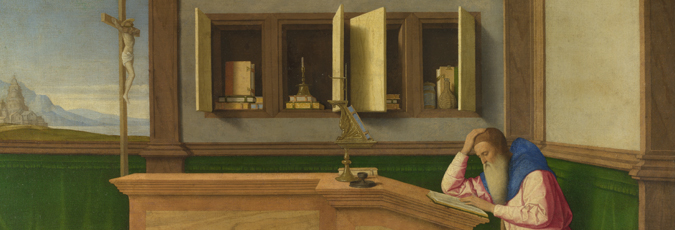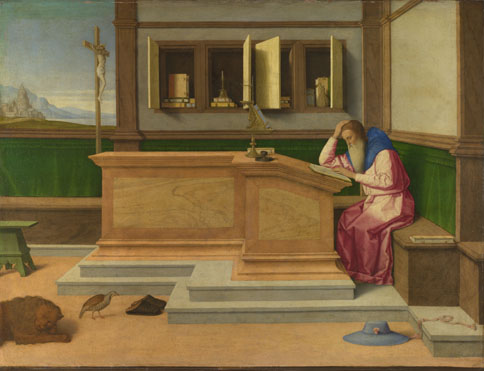Vincenzo Catena (active 1506–31)
'Saint Jerome in his Study', probably about 1510
Oil on canvas, 75.9 x 98.4 cm
NG694
The Venetian painter Vincenzo Catena may have been a pupil of Giovanni Bellini; certainly Bellini’s pictorial style was the most significant influence on his own manner. An inscription on the back of Giorgione’s celebrated ‘Laura’ (Kunsthistorisches Museum, Vienna) calls Catena the ‘collega’ (colleague) of Bellini, but the artistic innovations which Giorgione and Titian introduced to early 16th-century Venice made little measurable impact on him. For Catena, painting may have been more of a pleasure than a profession, as his commercial activities gave him some financial security. We know that he moved in intellectual circles, and included the humanist scholars Antonio di Marsilio and Giovanni Battista Egnazio among his friends. In fact, he is just the sort of painter who might have possessed a study – as the Mantuan court painter Andrea Mantegna and the Florentine Filippino Lippi both did.1 But although his picture of Jerome places the saint among the usual accoutrements of such spaces, there is no surviving documentary evidence of Catena’s own scholarly interests, or clear evidence that he possessed a library.
The scholar's desk
Catena shows Jerome seated at a vast desk, its dimensions exaggerated by its tidiness. The saint’s desk contains only three books (one of which he is reading), a bookstand, and a simple candlestick, perhaps made of pewter. The study is a very ordered and peaceful space. This is wholly appropriate for this Father of the Church, who had abandoned the hubbub of Rome (perhaps alluded to by the city in the left background) for the desert in order to pray and meditate, accompanied only by his devoted lion, which sleeps so calmly that a partridge is happy to stand beside it. However, in this respect it is unlike most 15th- and 16th-century depictions of studies (including Antonello da Messina's 'Saint Jerome in his Study'), which are more often than not so crowded with books, papers and ornaments, that the saint’s possessions take on a life of their own.
Having retreated from the world, Jerome reads in the quiet of his room. He is so at ease that he has removed his slippers (a detail also found in Antonello’s picture). Indeed, this picture is a truly habitable image; it is as though we, the viewer, are already in the painting. Its foreground is a spacious, open area awaiting our entry, with no framed threshold through which we need to step. All the structures within the image are also designed and built to be welcoming: note the L-shaped desk with its inviting steps, the empty space nearest the viewer at the end of Saint Jerome’s bench, as though we are about to join him there, the empty cupboards and the open window. It seems to be part of a visual metaphor for what Saint Jerome did to make the Bible accessible through translation.
Jerome's possessions
In Catena’s picture Jerome’s possessions are straightforward, but they are not simple. Books, candlesticks, a wooden Crucifix, a flask and a jar (presumably containing some simple food and drink) are the basics one might expect to find in a scholar’s cell. But these objects are carefully described, and of good quality. The books are skilfully bound, and decorated with metal clasps; while the brass candlestick in the second cupboard to the left resembles the elegant candleholders adorned with intricate silvered decoration that were made in Syria specifically for the Venetian market.2 The desk is well carved, and the finish of the wooden bench and panelling is fine (the wood grain of both is clearly visible). We are meant to admire the sheen of the green fabric (presumably a silken velvet) that hangs between the wooden wainscoting and the top of Jerome’s bench. But most beautiful of all is the book stand on Jerome’s desk, which again seems to be of brass, and is ornamented with a lion’s paw and some gilding. It is also functional – a spike for a candle has been inserted in the top, to make evening reading possible.
Several scholars have noticed that Jerome is wearing blue and pink, rather than the red in which cardinals are customarily shown; even his cardinal’s hat, which is placed on the floor in the right foreground, is a curious shade of light blue. His hooded cassock is a prominent blue, like those worn by Venetian parish priests in the early 16th century. It seems that Catena wished to show Jerome in his position as ‘the founder of Divine Office and the model for all ministers of the Church’, as it was put by the author of the ‘Divoto Transito di sancto Hieronymo’, an epistle purporting to be by Saint Jerome published in Florence in 1490.3 It is quite possible, as Giles Robertson argued 60 years ago, that Catena’s painting was made for just such a priest, and perhaps also for his study.4
Caroline Campbell and Amanda Lillie
Robertson 1954, p. 50; Gould 1975, pp. 51–2; Rice 1985, pp. 106–7; Russo 1987, pp. 198–9; Heinemann 1991, p. 105; Baker and Henry 1995, p. 104; Sander 2004, pp. 224–37.
This material was published in April 2014 to coincide with the National Gallery exhibition 'Building the Picture: Architecture in Italian Renaissance Painting'.
To cite this essay we suggest using
Caroline Campbell and Amanda Lillie, ‘Vincenzo Catena, Saint Jerome in his Study’ published online 2014, in 'Building the Picture: Architecture in Italian Renaissance Painting', The National Gallery, London, http://www.nationalgallery.org.uk/research/research-resources/exhibition-catalogues/building-the-picture/entering-the-picture/catena-saint-jerome


